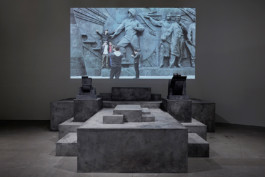↓ To Make Oneself Like Something Else




2014. multimedia installation. VIDEO DURATION 3:29 minutes
The multimedia installation investigates the power of images in the representation of political or historical events. For To make Oneself like Something Else a recording of Russian tourists at the foot of the Space Monument in Moscow is projected against a setting of a facsimile staircase and monumental pedestals. In the video recording we can observe visitors from many different regions of Russia who photographically immortalize themselves in front of - and directly on a relief. This relief depicts in social realist fashion the heroes of space travel: a cosmonaut, scientists, engineers, technicians and students.
The tourist visitors are undertaking a very physical attempt to relate themselves to the utopian ideas of their history by performing the gestures and poses of past heroes, by trying to blend into the texture of the relief. Sometimes this is done mockingly, sometimes sincere. Since the Cold War, space travel has been an important propaganda tool, it was part of the arms race between the USA and the USSR. Next to this it also was part of the philosophical movement of cosmism when the journey into space stood for a quasi religious function of science by enabling humans to leave the ultimate boundary that had been the surface and atmosphere of the earth.
History books from either side of the world portray this endeavor in unreliable ways, so for the visitors it is impossible to “find out the truth”. Despite all this, their poses and gestures allow them to create a performative relationship to their complex history.




↓ To Make Oneself Like Something Else




The multimedia installation investigates the power of images in the representation of political or historical events. For To make Oneself like Something Else a recording of Russian tourists at the foot of the Space Monument in Moscow is projected against a setting of a facsimile staircase and monumental pedestals. In the video recording we can observe visitors from many different regions of Russia who photographically immortalize themselves in front of - and directly on a relief. This relief depicts in social realist fashion the heroes of space travel: a cosmonaut, scientists, engineers, technicians and students.
The tourist visitors are undertaking a very physical attempt to relate themselves to the utopian ideas of their history by performing the gestures and poses of past heroes, by trying to blend into the texture of the relief. Sometimes this is done mockingly, sometimes sincere. Since the Cold War, space travel has been an important propaganda tool, it was part of the arms race between the USA and the USSR. Next to this it also was part of the philosophical movement of cosmism when the journey into space stood for a quasi religious function of science by enabling humans to leave the ultimate boundary that had been the surface and atmosphere of the earth.
History books from either side of the world portray this endeavor in unreliable ways, so for the visitors it is impossible to “find out the truth”. Despite all this, their poses and gestures allow them to create a performative relationship to their complex history.
2014. multimedia installation. VIDEO DURATION 3:29 minutes



